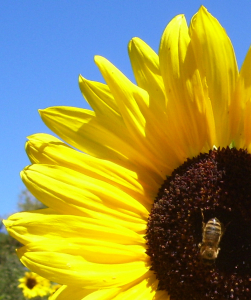I mentioned bees in my last post, and here we are again. As part of an occasional series on their rooftop apiary, the San Francisco Chronicle’s August 15 Garden section highlighted a visit from Queen Turner, the head of beekeeping for the Ministry of Agriculture in Botswana. Meanwhile, the August 19 issue of Time magazine blared a warning from its cover: A World Without Bees.
Bees—particularly honeybees—are big news. Unfortunately, as the Time cover indicates, that news is not good. Honey bees are dying in record numbers; hives are experiencing CCD (colony collapse disorder); beekeepers are at a loss to save their tiny charges. Is it neonoctinoids, a new class of pesticides? The Varroa destructor mite? Fungal infections like the Nosema ceranae? No one knows.
But whatever it is, we need to find out—and soon. Bees not only give us honey and beeswax—they are a major pollinator for foods like almonds, apples, avocados, blueberries, onions, cherries, watermelons and so many more foods, so if you like to eat, the bee is your friend. Additionally, they are aerodynamic marvels whose flying strategies are being studied by aeronautical engineers. Their eyes are inspiring new camera lenses. I could go on like this, and do in a section in the book that discusses the many ways bees of all types are our mentors:
It is difficult to overstate the importance of bees to the environment and to the well- being of humans. The more than twenty thousand species of bees are related to ants and wasps and are found anywhere in the world where flowers grow. Ranging in size from less than half an inch to the largest leaf- cutter bee at one and a half inches long, they’re a favorite meal for a range of birds and dragonflies. Yet, of all the bee species, only seven qualify as honeybees.
Let’s hope that bees are NOT having a moment—that in fact, they will be with us for a long time. Rather, let this bee-guiling moment be the one in which we appreciate their incredible value to human life.
Excerpt from The Shark’s Paintbrush, copyright Jay Harman. All rights reserved.







